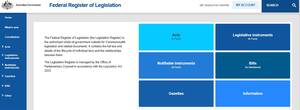AUSTRALIA REGULATIONS
General requirements for import
The Australia New Zealand Food Standards Code: Sets legal requirements for the safe handling of primary production and processing of foodstuffs.
The Code is a collection of food standards that are designed to:
· ensure that food is safe and suitable for human consumption;
· prevent misleading conduct associated with the sale of food;
· provide adequate information to enable consumers to make an informed choice and;
· provide an effective regulatory framework within which the food industry can work efficiently.
Relevant sections:
Chapter 3 - Standard 3.2.2 of the Code, “Food safety practices and general requirements”, information is provided about the hygienic requirements for food.
You can find the Australia New Zealand Food Standards Code at the following link
Imported Food Control Act: Provides guidance about the controls on the importation and movement of imported food, the Food Control Certificate, the Food Inspection Scheme and the Quality Assurance Certificates in its Part 2 – Division 1.
You can find the Imported Food Control Act at the following link
The Biosecurity Act: Establishes requirements and regulatory powers that affect how the department manages the bio-security risks associated with food imported into Australia.
This Act is specific to pests and other unwanted microorganisms and provides guidance about the import health standards. These standards outline requirements to be met for the effective management of risks associated with importing unsafe food; including risks arising because importing the goods involves or might involve an incidentally imported new microorganism.
You can find the Biosecurity Act at the following link
Additives, contaminants, antimicrobials and residues
The Australia New Zealand Food Standards Code: Provides guidance about additives, contaminants and residues that are permitted to be added to food sold in Australia, their standards and their maximum levels.
Relevant sections of the Code:
Chapter 1 - Standard 1.3.1: Food additives
Schedules:
- Schedule 7: Food additive class names (for statement of ingredients)
- Schedule 8: Food additive names and code numbers (for statement of ingredients)
- Schedule 15: Substances that may be used as food additives
- Schedule 16: Types of substances that may be used as food additives
Chapter 1 – Part 1.4: Contaminants and residues
Schedules:
- Schedule 19: Maximum levels of contaminants and natural toxicants
- Schedule 20: Maximum residue limits
You can find the Australia New Zealand Food Standards Code at the following link
The Australian Pesticides and Veterinary Medicine Authority (APVMA) is a database that maintains current details about agricultural and veterinary chemical products registered for use in Australia or which may be available for off-label use under a minor-use permit. This database includes the product name, registering company, active constituents, product category, and host and pest information.
You can find the Australian Pesticides and Veterinary Medicine Authority at the following link
Microbiological and organic criteria
The Australia New Zealand Food Standards Code: Provides guidance about the microbiological maximum limits.
Relevant sections of the Code:
Chapter 1 - Standard 1.6.1: Microbiological limits in food
Schedule 27: Microbiological limits for foods
You can find the Australia New Zealand Food Standards Code at the following link
Traceability
Imported Food Control Act: Provides guidance about the imported food inspection advice, the treatment, destruction, or re-exportation of non-compliant food in its Part 2 – Division 2 and 3.
You can find the Imported Food Control Act at the following link
The Australia New Zealand Food Standards Code: Covers the “one step back and one step forward” elements of traceability for foodstuffs
Relevant sections:
Standard 3.2.2 (Chapter 3) provides general traceability requirements; and
Standard 4.2.1 (Chapter 4) gives specific requirements for seafood.
You can find the Australia New Zealand Food Standards Code at the following link
Regional Plan of Action against IUU fishing (RPOA-IUU): A ministerial initiative with the aim to promote responsible fishing practices and combat Illegal, Unreported and Unregulated (IUU) fishing in the Southeast Asian region.
National Plan of Action against IUU fishing (NPOA-IUU): Provides an overview of impacts of IUU fishing on Australia's fisheries management arrangements. The plan outlines Australia's key domestic measures, initiatives and possible future actions to combat IUU fishing.
Australia's Second National Plan of Action to prevent, deter and eliminate Illegal, Unreported and Unregulated Fishing: provides an overview of impacts of IUU fishing in Australia, outlines Australia’s keys domestic, regional, and international measures and initiatives to combat IUU fishing. The Second National Plan outlines future actions to combat IUU fishing.
You can find the Plans of Action against IUU fishing at the following link
Labelling and Packaging
The Australia New Zealand Food Standards Code: Includes general labelling and requirements that are relevant to all foods, and sets out which requirements apply in different situations (e.g. food for retail sale vs food for catering purposes). Chapter 2 also includes specific labelling and information requirements that apply to fishery products.
Relevant sections:
Chapter 1 - Part 1.2: Labelling and other information requirements
Chapter 2 - Standard 2.2.3: Fish and fish products
You can find the Australia New Zealand Food Standards Code at the following link
How do you find the most recent consolidated version of the regulations?
You can find the Australia New Zealand Food Standards Code at the following link
You can find the Imported Food Control Act at the following link
For all the other legal texts please visit the following link, you can insert the name of the law/act/regulations under the box “Search” to find them:

https://www.legislation.gov.au/
Last updated: 31/08/2022
Cover photo: Bernard Spragg on FlickR (CC0 1.0)


